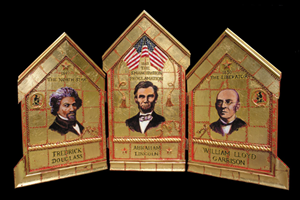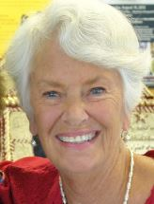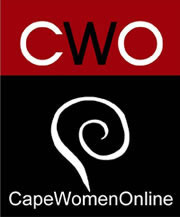CapeWomenOnline - Where Cape Women Shine
Your local venue for the women of Cape Cod to share their ideas, experiences and resources while inspiring each other in their life's journey
Inspire . Encourage . Network . Share

Celebrating the 150th Anniversary of The Emancipation Proclamation
by Pamela Purdy
As an artist who created the series, Icons of the Civil Rights Movement, I felt driven to create an icon of The Emancipation Proclamation. The unfulfilled promise of that proclamation 150 years ago led to the Civil Rights Movement.
In 2007, in preparation for the Civil Rights series, I took a gold leaf workshop in New Hampshire. The decision to do these in iconic form sprang from a need to depict the people and events in a sacred way. Traditionally gold leaf was used in religious icons to enhance the sacredness of the subject depicted. The display of non-violence and the power of trans-formative love said it all.
I designed the icons in various shapes, some suggesting a tablet, a headstone, a Torah, a church window. Once the shapes were cut, found materials were used: chains, moldings, glass and collage. I let the underlying red paint show through to represent the blood sacrifice, the holy spirit, the passion of the movement.
After viewing on PBS The Abolitionist, I was inspired to create an icon of Fredrick Douglass, Abraham Lincoln and William Lloyd Garrison. See the names of the abolitionist newspapers, The North Star and The Liberator. Note the use of chain, the entwined keys under Douglass and Garrison. Note the open lock and broken chain under Lincoln. The chains of slavery are broken. Note the medallions of slavery on the left and right of the Douglass and Garrison portraits.
The now 31 icons will appear in the second edition of our book Icons of the Civil Rights Movement. We went out on a limb and self published the first edition with West Barnstable Press. My husband, David, did the research and text; my artwork illustrates the book.
We ordered 1600 copies, printed in this country, not outsourced. We have just about sold out these books in 10 months.
The Zion Union Heritage Museum on 276 North St. Hyannis, the Museum that houses the exhibit during the summer, is responsible for most of these sales. Bus tours from all over the country come to this museum. I get to talk to these people, sign books and receive accolades of love and support. Many of them share stories of their own involvement in the "movement".
The mission of this book is to make sure that these people and events are never forgotten. For exhibit schedule updates and to learn more about these icons visit www.chatterton-purdyart.com
This book is available at
www.chatterton-purdyart.com
and www.amazon.com
Emancipation Proclamation
"I never, in my life, felt more certain that I was doing right than I do signing the paper." President Abraham Lincoln
Frederick Douglass has been called the father of the Civil Rights Movement. Through determination, oratory eloquence and the written word, he helped to shape the national conversation about race.
Douglass was an African-American born in 1818 into slavery in Maryland. He escaped from slavery with the assistance of a free black woman, Anna Murray, who later became his wife. With the friendship of William Lloyd Garrison, he rose to prominence in his own right as an orator on the abolitionist speaking circuit where he recounted his suffering under slavery and his flight to freedom in the North. He began publication, in 1847 of his own newspaper, The North Star, which carried his own and the writings of other abolitionists.
During the Civil War, Douglass met with President Abraham Lincoln at the White House where he urged the President to work more swiftly on black emancipation and the recruitment of black men for the Union Army. After the Civil War and up to his death, in 1895, he continued to the battle for equal rights for African-Americans and voting rights for women.
President Abraham Lincoln responded to the secession of the Southern states and their attack on Fort Sumter, S.C. by going to war to save the Union. Though Lincoln personally found the institution of slavery abhorrent, he believed that neither the North nor the border states would support the abolition of slavery as an overarching purpose of the Civil War.
As thousands of slaves fled the South and joined with the invading Union forces, Lincoln became convinced that abolition was both militarily and morally justifiable. On January 1, 1863, the President issued the Emancipation Proclamation which freed the slaves in the 10 rebellious states of the South and allowed former slaves to serve with pay in the Union army.
It also made the abolition of slavery in the United States an explicit goal of the War. At the beginning of his second term, Lincoln pressed Congress to pass an amendment banning slavery throughout the United States and its territories. By December, 1865, the 13th Amendment to the Constitution was ratified by a sufficient number of states.
William Lloyd Garrison was born in 1805, in Newburyport, Massachusetts. After an apprenticeship as an editor and writer in his hometown, he moved to Boston where he learned of the anti-slavery movement. He began his own newspaper, The Liberator, in 1830 which promoted the cause of abolition.
He organized the American Anti-slavery Society which was dedicated to the termination of slavery in the United States. Frederick Douglass and Garrison toured together giving anti-slavery speeches in the Appalachian region of the country.
Because he believed the U.S. Constitution condoned slavery, he broke ranks with the many pro-Union abolitionists who had been his close associates. Though a life-long pacifist, Garrison did support Abraham Lincoln and his Civil War policy. With the adoption of the 13th Amendment, his own abolitionist efforts came to fruition. At his funeral in 1879, Frederick Douglass eulogized: "...the brightest and steadiest of all the shining hosts of our moral sky has silently and peacefully descended below the distant horizon...."

Pamela Chatterton-Purdy graduated from New Canaan Conn. High School in 1959; received an A.A. from Green Mountain College in 1961, her B.A. from The University of New Hampshire in 1963.
She married her husband David Purdy, a Methodist Minister, June 7, 1963 and received her M.F.A. from The University of Massachusetts in 1966. She has taught art at Bay Path College, Longmeadow, MA, Springfield College, Springfield MA, and The University of Massachusetts at Amherst, plus the public schools of Middleboro, MA and Brookline MA. She has taught art for over 30 years.
In 1987, Pamela wrote a book titled BEYOND THE BABYLIFT, A Story of an Adoption. It was published by Abingdon Press, Nashville TN. The Purdy's have 4 children and the book focuses on the adoption of the Purdy's Amer-Asian child and the struggle to become a family.
In retirement Pamela has created a series called "Icons of the Civil Rights Movement" which has traveled to over 24 Colleges and Universities. In January 2009 the show went to Washington DC for the Inauguration of President Barack Obama.
In 2012, Pamela and her husband published a book Icons of the Civil Rights Movement, her husband doing the research and text featuring Pamela's artwork. When the show is not traveling, it resides at The Zion Union Heritage Museum 276 North St. Hyannis, Mass.
For more information about Pamela Purdy visit: www.chatterton-purdyart.com


